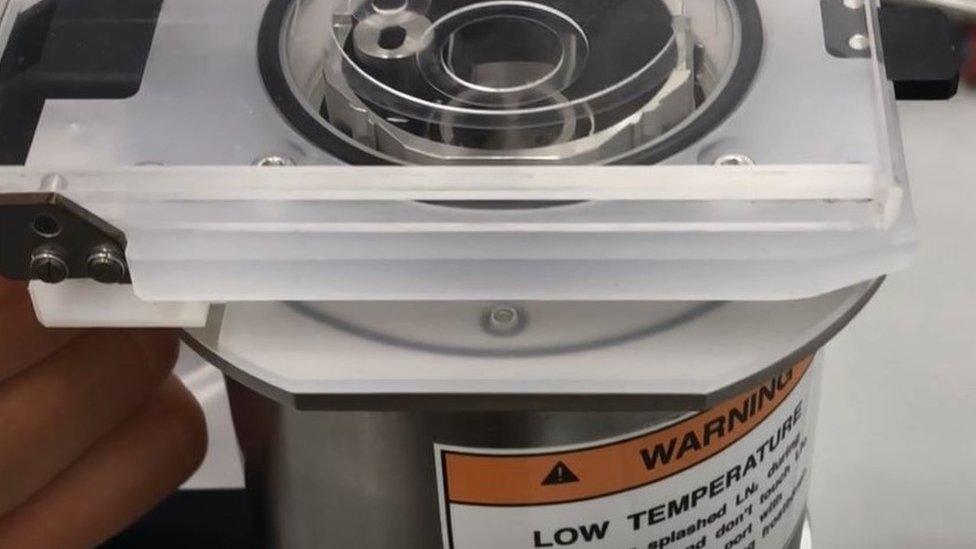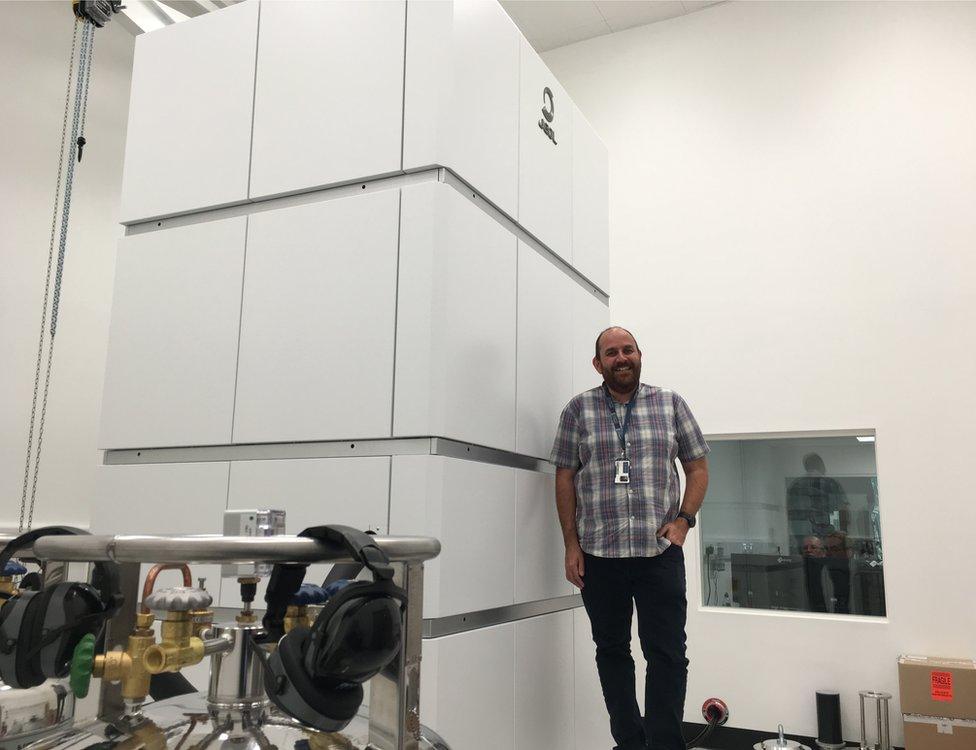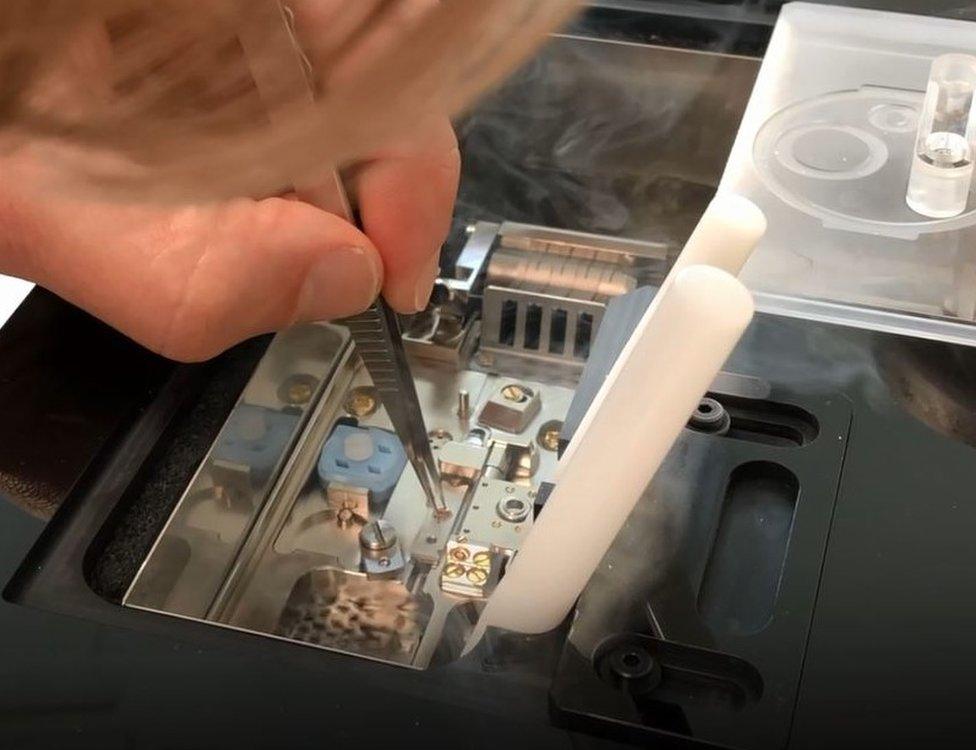New Glasgow research centre houses 'cool' microscope
- Published

The microscope is designed to look at specimens at liquid nitrogen temperatures
A new centre is opening that will enable researchers to look at the fundamentals of life in unprecedented detail.
It is expected to lead to a new generation of treatments for hitherto deadly diseases.
The Scottish Centre for Macromolecular Imaging (SCMI) is a collaboration between the universities of Glasgow, Edinburgh, Dundee and St Andrews.
At its heart stands a massive and powerful electron microscope that images samples frozen to -196C.
The JEOL Cryo ARM 300 is the first of its kind in Scotland and one of only a handful worldwide.
Dr David Bhella is the director of SCMI. He is dwarfed by the microscope's huge structure. It looks a little like an albino version of the monolith from 2001: A Space Odyssey.
"It's a high voltage transmission electron microscope that's designed for looking at specimens at liquid nitrogen temperatures," he says.

The huge JEOL Cryo ARM 300 is the first of its kind in Scotland
The underlying principles are twofold: electrons are used because the specimens have features that are smaller than the wavelengths of light. Photons are just too big and clumsy to create images at the atomic level.
The low temperatures - the cryo part - are because the fundamental mechanisms of life tend to move about and need to be stabilised, in this case frozen in liquid ethane, before being placed in the beam of electrons. It's the equivalent of saying "hold it" before taking a photo.
The new microscope has not come cheap. It accounts for most of the SCMI's £5m cost.
That means several organisations, not just the four universities, have had to dig deep. Money has come from the Medical Research Council (MRC) as part of £11.3m government funding from the Department for Business, Energy and Industrial Strategy.
Additional support came from the Scottish Funding Council, the Scottish Universities Life Sciences Alliance, the Beatson Institute for Cancer Research and the MJM Smith Trust.
Increasingly precise images
The prize in return will be a revolution in medicine.
Dr Bhella's interest is in the structures inside viruses. The SCMI is housed inside the MRC's Centre for Virus Research on Glasgow University's Garscube Estate.
"If you put 10,000 virus particles in a line, that line would be the size of a full stop," he says.
Other researchers will look at other basic biological structures such as enzymes or proteins which cause - or could stop - cancers.
The field is called cryoEM - cryogenic electron microscopy.

The Scottish Centre for Macromolecular Imaging (SCMI) is a collaboration between the universities of Glasgow, Edinburgh, Dundee and St Andrews
Dr Bhella and others have been working on it for decades but it is only in the last few years that sophisticated software and massive computing power have been able to contribute to creating increasingly precise images.
The Scottish biologist Dr Richard Henderson shared the 2017 Nobel Prize in Chemistry for his role developing the technique.
He is opening the Glasgow facility on Tuesday and on Wednesday he will be at Didcot in Oxfordshire for the inauguration of the electron Bio-Imaging Centre (eBIC), which boasts a cluster of similarly powerful and advanced cryogenic microscopes.
eBIC is part of the Diamond Light Source, the UK's national synchrotron. One of its directors, Jim Naismith, is professor of structural biology at Oxford University. He says cryoEM offers a superior way of handling samples:
"Five years ago the only really efficient way to do that was to grow them into crystals," he says.
"But that is difficult for the very complex materials that are found in the human body.
"Electron microscopy doesn't require you to grow crystals and it's potentially a game changer in our ability to see the most challenging and important targets in medicine."
He says cryoEM will make a difference with "all diseases".
Dr Bhella agrees: "We have colleagues who work on cancer biology, on fundamental processes like proteins that manipulate DNA.
"We can really think about rationally designing medicines to interfere with fundamental biological disease processes in many, many different spheres: cancer biology, infection biology, neurology.
"Depending on the kind of protein you're studying, you can begin to try and solve those fundamental medical problems."
Two cryoEM facilities may, like buses, have come along at once. But they are not in competition.
There are Scottish researchers working at each facility and some at both. Other centres are blossoming across the UK as demand grows.
Once scientists were criticised for knowing more and more about less and less. Now they know more about smaller and smaller. And that's a good thing.